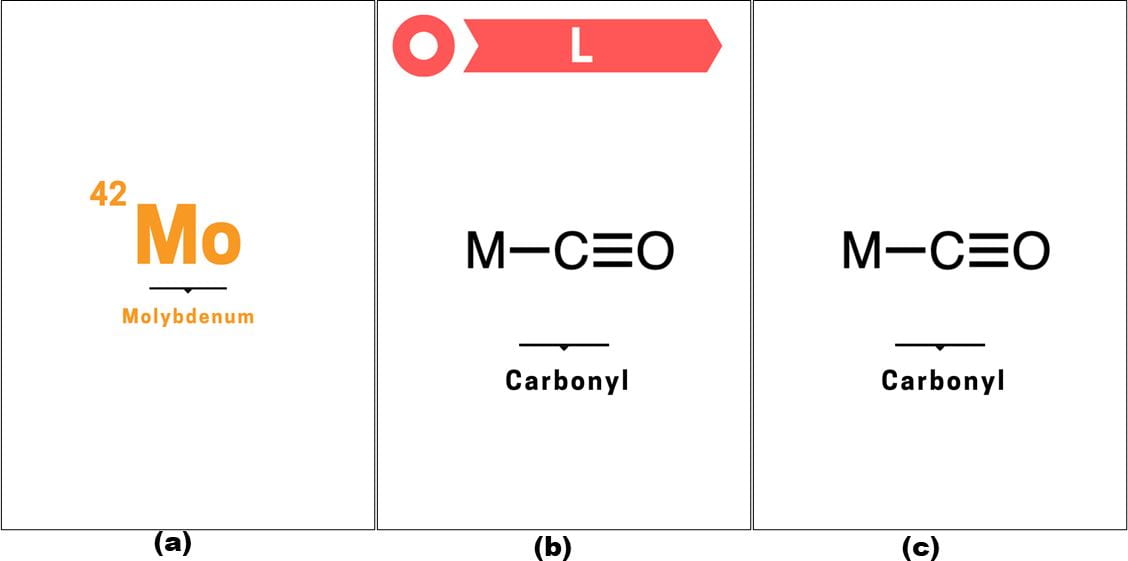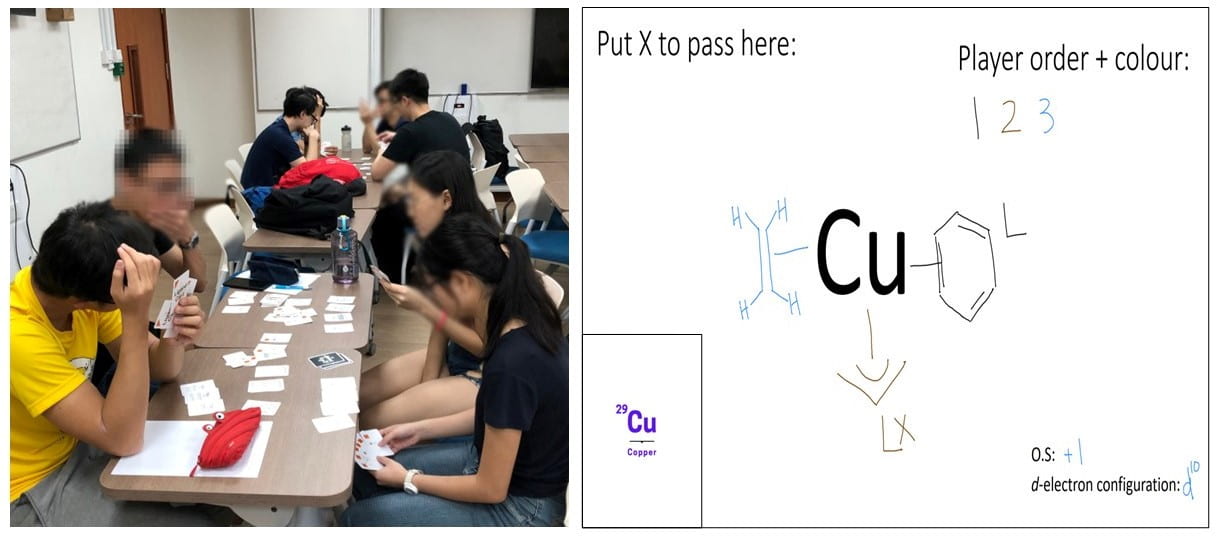FOO Maw Lin and ANG Wee Han
Department of Chemistry, Faculty of Science (FoS)
Maw Lin and Wee Han recount the process of developing the card game CountQuest to reinforce students’ understanding and mastery of electron counting, an essential concept in their inorganic chemistry course.

Photo by Andy Barbour from Pexels.
Foo, M. L., & Ang, W. H. (2023, July 26). CountQuest: A card game to reinforce electron counting concepts in inorganic chemistry. Teaching Connections. https://blog.nus.edu.sg/teachingconnections/2023/07/26/countquest-a-card-game-to-reinforce-electron-counting-concepts-in-inorganic-chemistry/
Introduction
Electron counting is a key foundational concept taught in the Year 2 course CM2111 “Inorganic Chemistry 2” to predict and rationalise the formulae for stable metal-containing compounds. To obtain the total electron count of a neutral compound, the individual valence electron counts of both the metals and ligand constituents are added. Stable compounds typically have a total electron count of 18, hence this concept is often taught as the “18-electron rule” (Sidgwick, 1934). To achieve mastery of this concept, students need to put in copious amounts of practice, particularly to recognise and assign the nature of the metal-ligand bonding interaction. We have observed that the traditional instructional method via lectures and tutorials is not interactive, where students may get bored and consequently do not practice enough of the assigned examples to be fully proficient.
Developing CountQuest for Mastery of Electron Counting Concepts
We note that in the education literature, games can be used to promote active learning through play, leading to improved engagement and motivation (Plass, 2015). In addition, game mechanics can allow players to repeatedly perform certain procedures or actions which leads to mastery of skills (Murphy, 2012) while minimising boredom. Thus, we developed a card game called “CountQuest” to reinforce students’ understanding and mastery of electron counting taught during lectures.
We started off with physical card games as they are cheap to develop and scalable for classroom use. We subsequently developed a digital version of the game which can be played over Zoom, which enabled us to continue implementing this activity amidst COVID-19 pandemic restrictions. This article briefly describes the game and preliminary results from AY 2019/20 to AY 2020/21; readers interested to find out more can refer to our publication (Tan et al., 2022) for further details.
CountQuest consists of a stack of labelled metal cards and a stack of inorganic/organic ligand cards with various ligand types employing Green’s (1995) classification. The design of the ligand cards also incorporated important concepts taught in CM2111, such as hapticity and coordination isomerism. In addition, the name of the ligand (i.e. carbonyl, seen in Figure 1) is written on each ligand card for students to revise ligand naming. There are two set of ligand cards, “labelled” and “unlabelled” with ligand type, which allows different levels of play for scaffolding of learning. The lowest level of play (Level 1) uses labelled ligand cards (Figure 1b) for students to familiarise themselves with the rules of gameplay, followed by Level 2 which uses unlabelled ligand cards (Figure 1c).
Figure 1. (a) Metal card, as well as the (b) labelled, and (c) unlabelled ligand cards.
The game mechanics involved students being divided into groups of three to five players and taking turns to add a card from their pre-allocated ligand cards to an exposed metal card from the metal card pile, with the goal of constructing a metal-ligand complex with a particular electron count. Thus, the game mechanics ensures that the students are practising electron counting while playing the game. When a player successfully eliminates all his/her cards in the ligand deck, the game is completed. A pictorial reward card is given to the winning player. It is noted that in game-based learning, the use of rewards increases motivation due to higher levels of enjoyment (Abdul Jabbar, 2015).
CountQuest was first developed as a face-to-face card game during AY 2019/20 and students played the game during one-hour tutorial sessions. However, with classes moving online in AY 2020/21, the game format was modified and students played an online version using Zoom breakout rooms, with each room helmed by a student facilitator. The game was played using Zoom’s “Share Screen” function, where students use a screen-shared PowerPoint slide with the ligands “sketched” at each turn using the “Annotate” function. Figure 2 shows the face-to-face and online versions of the gameplay for CountQuest.

Figure 2. Two formats of the gameplay for CountQuest: (left) face-to-face gameplay, and (right) the online version where students sketch on a screen-shared PowerPoint slide in Zoom.
Preliminary Survey Findings
Students also responded to survey questions regarding their perceptions of content mastery, game design, and method of learning, administered immediately after playing CountQuest. We highlight two significant results (Table 1). The first pertains to responses for the pre-, post- game question (Q1) “Overall, I am confident in electron counting for metal complexes”, which shows a marked increase in the percentage of students who “Agree” and “Strongly Agree” in both years, indicating that engagement with CountQuest increased students’ confidence in electron counting after gameplay. The second pertains to responses to the post-game question (Q2) “Being able to play the game with my peers helps me to identify my mistakes/misconceptions”. The results indicate that greater than 80% “Agree” and “Strongly Agree” for both years, which highlights the importance of peer learning in CountQuest for improving the concept of electron counting among students taking CM2111.
Table 1
Survey results for the pre-post game (Q1) and post-game (Q2) questions, showing the sum of percentages of “Agree” and “Strongly Agree”

Summary
We developed a card game, CountQuest that can be played face-to-face or online, which reinforces the electron counting concept taught during CM2111 lectures. The post-game survey findings indicate a marked increase in students’ perception that they are more confident in identifying course-related mistakes/misconceptions after playing CountQuest with their peers, highlighting the importance of peer learning. Based on our experience in developing CountQuest, we encourage fellow educators to develop game-based learning to reinforce student learning from lectures.
Acknowledgments
The authors would like to thank Mr Tan Lai Heng and Ms Justina Tan Hui Rui for assisting in this research, CM2111 students for their participation and financial support from the Centre for Development of Teaching and Learning (CDTL).
This Learning Improvement Project was made possible due to the generous support of a Teaching Enhancement Grant (TEG) from CDTL.
References
Abdul Jabbar, A. I., & Felicia, P. (2015). Gameplay engagement and learning in game-based learning: A systematic review. Review of Education Research, 85(4), 740-79. https://doi.org/10.3102/0034654315577210
Green, M. L. H. (1995). A new approach to the formal classification of covalent compounds of the elements. Journal of Organometallic Chemistry, 500(1), 127-48. https://doi.org/10.1016/0022-328X(95)00508-N
Murphy, C. (2012). Why games work and the science of learning. Selected Papers Presented at MODSIM World 2011 Conference and Exp. , https://ntrs.nasa.gov/citations/20130008648
Plass, J., Homer, B. & Kinzer, C. (2015). Foundations of game-based learning. Education Psychologist, 50(4), 258-83. https://doi.org/10.1080/00461520.2015.1122533
Sidgwick, N. V., & Bailey, R. W. (1934). Structures of the metallic carbonyl and nitrosyl compounds. Proc. Roy. Soc. A, 144(853), 521-37. https://doi.org/10.1098/rspa.1934.0066
Tan, H. R. J, Ang, W. H., & Foo, M. L. (2022). CountQuest: A card game played on Zoom for revising effective atomic number concept. Journal of Chemical Education, 99(6), 2425-30. https://doi.org/10.1021/acs.jchemed.1c01286.
 |
FOO Maw Lin is a lecturer from the Department of Chemistry at the Faculty of Science (FoS), and has previously taught chemistry and materials science in the United States, Canada, and Japan. He is passionate about using game-, group-, and problem-based learning to enhance critical thinking in science students. Maw Lin can be reached at chmfml@nus.edu.sg. |
 |
ANG Wee Han is an Associate Professor from the Department of Chemistry at FoS. He specialises in medicinal and biological inorganic chemistry and leads a research group developing late-transition metal complexes for therapeutic purposes. Wee Han can be reached at chmawh@nus.edu.sg. |

